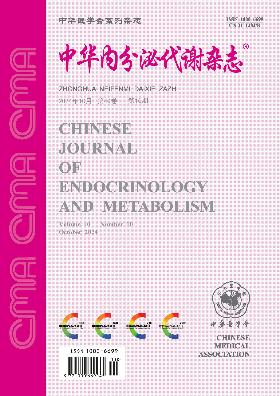低密度脂蛋白受体相关蛋白5基因D111Y突变致骨硬化1例
Q4 Medicine
引用次数: 1
摘要
目的探讨一个骨硬化家族的临床特点及致病基因。方法对江苏某家庭6例患者及6名家庭成员进行生化指标、骨代谢指标、骨密度、胸腰椎前侧片、头颅侧位正片及盆腔平片检测。同时进行Sanger测序检测先证及其他5名高骨量家族成员的基因突变。通过SWISS-MODEL预测突变低密度脂蛋白受体相关蛋白5 (LRP5)蛋白的构象。结果4例成人患者(男1例,女3例)身高、下颌骨增大、下颌中央后凸,均无骨折。他们的X线检查显示颅骨和长骨皮质增厚,而鞍和下颌骨则变大。此外,所有患者各部位骨密度绝对值均明显高于标准年龄和性别匹配的成人或青少年平均参考值,L2-4、股骨颈和全髋关节的Z评分分别为(6.31±4.03)SD、(6.56±2.36)SD和(7.19±2.03)SD。基因测序结果显示,6例患者均携带一个杂合突变(c.331G>T;LRP5基因2外显子D111Y),而其他家族成员为野生型(c.331G>G;D111D)。功能预测表明,该突变位于LRP5基因外显子2的氨基酸末端,编码LRP5蛋白的第一个β-螺旋产生区。结论LRP5基因D111Y突变导致临床表型为良性骨密度增高,但不增加骨折风险。这种突变可能通过改变LRP5蛋白的空间结构进一步影响下游的Wnt信号通路,从而促进成骨细胞的成熟和分化,导致骨硬化。关键词:骨硬化;低密度脂蛋白受体相关蛋白5;功能增益;Wnt信号通路本文章由计算机程序翻译,如有差异,请以英文原文为准。
One family with osteosclerosis caused by D111Y mutation in the low-density lipoprotein receptor-related protein 5 gene
Objective
To investigate the clinical features and pathogenic genes of a family with osteosclerosis.
Methods
Six patients and six family members from a family in Jiangsu were tested for biochemical parameters, bone metabolic markers, bone mineral density, thoracolumbar anterior lateral slices, skull positive lateral radiographs, and pelvic plain films. Meanwhile, Sanger sequencing was performed to detect gene mutations of the proband and five other family members with high bone mass. The conformation of the mutational low-density lipoprotein receptor-related protein 5 (LRP5) protein was predicted by SWISS-MODEL.
Results
Four adult patients (one male and three females) were tall, with mandibular enlargement and kyphosis in the center of the lower jaw, and none of the four had fractures. Their X ray examination revealed that the skull and long bone cortex was thickened, while the sella and mandible was enlarged. In addition, the absolute values of bone mineral density at each site of all patients were significantly higher as compared with the standard age- and sex-matched adults or adolescent mean reference values, with Z scores of L2-4, femoral neck and total hip being (6.31±4.03) SD, (6.56±2.36) SD, and (7.19±2.03) SD, respectively. The results of genetic sequencing revealed that all six patients carried a heterozygous mutation (c.331G>T; D111Y) in exon 2 of LRP5 gene, while other family members showed wild type (c.331G>G; D111D). Functional prediction indicated that this mutation was located at the amino acid terminal of exon 2 of LRP5 gene, which encodes the first β-helix-generating region of LRP5 protein.
Conclusion
The D111Y mutation in LRP5 gene leads to a clinical phenotype characterized by benign increased bone mineral density without increasing the risk of fracture. This mutation may further affect the downstream Wnt signaling pathway by altering the spatial structure of LRP5 protein, thereby promoting maturation and differentiation of osteoblasts and resulting in osteosclerosis.
Key words:
Osteosclerosis; Low-density lipoprotein receptor-related protein 5; Gain of function; Wnt signaling pathway
求助全文
通过发布文献求助,成功后即可免费获取论文全文。
去求助
来源期刊

中华内分泌代谢杂志
Medicine-Endocrinology, Diabetes and Metabolism
CiteScore
0.60
自引率
0.00%
发文量
7243
期刊介绍:
The Chinese Journal of Endocrinology and Metabolism was founded in July 1985. It is a senior academic journal in the field of endocrinology and metabolism sponsored by the Chinese Medical Association. The journal aims to be the "Chinese broadcaster of new knowledge on endocrinology and metabolism worldwide". It reports leading scientific research results and clinical diagnosis and treatment experience in endocrinology and metabolism and related fields, as well as basic theoretical research that has a guiding role in endocrinology and metabolism clinics and is closely integrated with clinics. The journal is a core journal of Chinese science and technology (a statistical source journal of Chinese science and technology papers), and is included in Chinese and foreign statistical source journal databases such as the Chinese Science and Technology Papers and Citation Database, Chemical Abstracts, and Scopus.
 求助内容:
求助内容: 应助结果提醒方式:
应助结果提醒方式:


